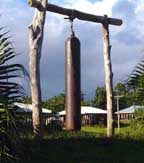HOME PAGE
FAMILY EMERGENCY PLAN
FAMILY FINANCES
LONG TERM FOOD STORAGE
5 DAY SURVIVAL KIT
SURVIVAL GUIDE
LONG TERM SURVIVAL
FIRST AID
COMMUNICATIONS
GARDENING
TERRORIST ATTACKS
EARTHQUAKE SURVIVAL
SANITATION
KNOT TYING
DUTCH OVEN COOKING
GUN MAINTENANCE
AMMUNITION RELOADING
"I want you to be concerned
about your neighbor, do
you know your neighbor?"
- Mother Teresa
COMMUNICATIONS
After we have taken care of our families basic needs the next
item will be communication with others. We will want to pick up
the latest news, track down friends and family
or just a need to feel you are not alone. This section will give
you ideas on how to start preparing your communications package.

For long distance
sending and receiving, only "ham" radios will work. If you need this information,
search the web. There are ham radio's available that are fitted into a small suitcase,
one side of which is composed of a solar panel with
gel cell batteries behind the panel. These are expensive, need a long antenna
array to work properly, and require a good deal of practice and skill to
operate reliably. Those who like to experiment may find that a ground
antenna will work instead of a highly visible tall
antenna tower.

Short range sending and receiving is now the province of FRS/GMRS radios. In the past few years new models have become available which are reliable, inexpensive, and charge from both 110 and 12 volt power sources. The difference in range between the 4 and 5 watt units is not great, but the price difference is! A small GMRS radio will enable one to coordinate communications (and therefore actions) with neighbors and friends. Be sure to set each unit to an unusual frequency, say channel 18 - 1, so everyone within distance can send and receive easily. The distance limitation of the units depends considerably on the terrain. One sharp mountain ridge blocks the signal, even though a 4 watt unit says they are good for 12 miles or so, and a 5 watt unit up to 15 miles, as that measurement is across flat ground. With low ridge lines, reliable transmission is limited to about 4 or 5 miles...but for short range communications, that is enough for use by "lookouts."
For medium range sending and receiving, portable hand held CB units are relatively inexpensive, have a range of at least 5 miles, and operate off a 12 volt DC battery source. The battery may be recharged with a solar panel. For "citizen patrols," the CB radio concept is ideal. With 40 channels available, it is possible to switch frequencies on the hour, for example, to lessen the chance of alerting the wrong people of the intended consequences of their being spotted. Just remember that anyone, even the bad guys, can listen in and therefore know what is being said.
WHEN ALL ELSE FAILS
It is still possible to
have a neighborhood communication "alert" system just like the old
days, using a loud bell and a known code for the number of chimes (1 chime =
alert; 2 = major alert; 3 = immediate danger, etc). Large brass bells are a
thing of the past or extremely expensive, cast iron bells are fragile and
mostly for "atmosphere" and looks, but you can build a good bell
yourself. 
 to learn more about Ground Antennas, Faraday Cages and Frequency Listings
to learn more about Ground Antennas, Faraday Cages and Frequency Listings